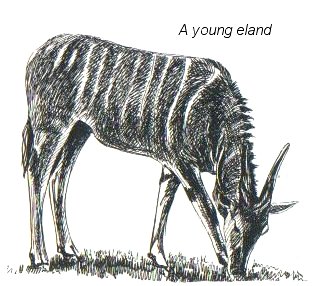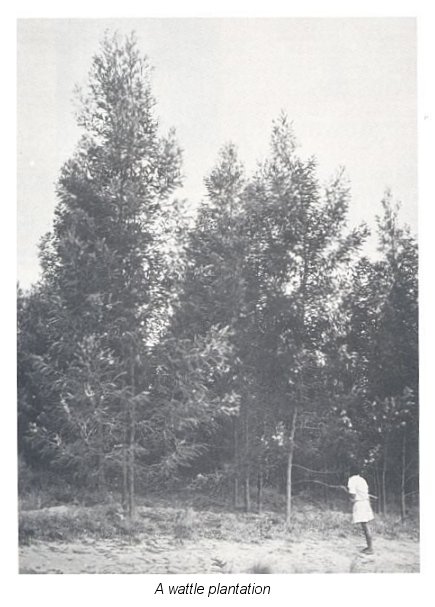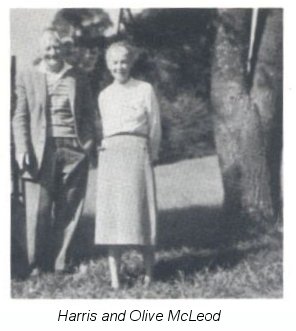
Eland damaged some crops, and farmers were told that they were allowed
to shoot eland throughout the year on a �1 licence, but were not to abuse the
privilege by indiscriminate destruction.
Melsetter was clear of A.C.F. for three years but was disappointingly
back into difficulties at the beginning of 1943 with an outbreak on Rocklands,
which it was hoped could be controlled and contained, but this was not
possible.
Some of the difficulties are shown in Albany�s case. In November
1943 two people were given permission to camp on Albany: only much later it was
learned that they had come from camping on Rocklands and that they had
a small woolly dog with them. Whether the infection was due to their
visit will never be known, but it is a strong possibility.
Visits from Cattle Inspectors had always been regular on dipping days,
and in February 1944 Bill Baker came with ominous news of suspected A.C.F. on
Albany, and for the next few weeks he and his wife stayed frequently while Pat
and he were very busy getting a good check of all the cattle. The District
Veterinary Surgeon from Umtali came,
a succession of cattle inspectors
visited daily for months, most usually stayed overnight, and a careful watch was
kept on the cattle.
No definite A.C.F. signs were found, and in February and March Pat
Sinclair exchanged Friesland cows for Shorthorn heifers from Cashel, bought
weaners from Dawid Wiese at Cecilton, and sold cattle to Dredge at Skyline. In
September came the bad news that Koch�s bodies had been found in the slide of a
cow which had been sick for six weeks and had died two weeks before. And Albany
was in quarantine for A.C.F.
Five-day dipping with daily temperaturing of cattle started immediately
and movements of stock on the farm were carefully controlled. Pat built a second
dipping tank and put up extra fencing, on the boundary between Albany and
Heathfield a double fence was erected with a 50-yard buffer gap, and Veterinary
guard boys were on duty at each of the farm exit gates. Successive Chief
Veterinary Surgeons came, and when T. Lees May was posted as D.V.S. to Melsetter
he and his wife spent much time on Albany.
In November A.C.F. was diagnosed in a sick heifer which had been
slaughtered, but the relief was great when a cow was postmortemed in December
and poisoning was diagnosed. The anxiety went on: cattle with temperatures at 6
a.m., slides positive, slaughtered. Temperatures suspicious, cattle off colour,
slides negative, the cattle left to be carefully watched. A whole span of oxen
was slaughtered on suspicion, and the Shorthorn calves were said to have Koch�s
bodies in the smear, but Pat refused to allow them to be slaughtered, and they
showed no further signs of ill-health. A labourer�s ox died and A.C.F. was
confirmed: that ox had been moved without permission and had infected more veld,
which resulted in more anxiety. Telephones hummed and visitors flowed.
Officials were held up in reaching the farm because of flooded drifts:
the weather was definitely against any easy handling of cattle with a lot of
rain and dreadfully muddy conditions: once an umbrella, of all things, was
borrowed to go out and deal with a sick beast. A friend picked a huge bunch of
heath, but she was not allowed to take it off the farm, as nothing could be
taken off Albany while in quarantine.

At last, some eighteen months after the final confirmed A.C.F. death,
Albany was announced to be out of quarantine. It is impossible to assess the
losses, which were actually not great in numbers of cattle dead but other items
mounted up: loss of condition of the cattle through constant handling, the
inability to run as many cattle as planned, the extra fencing and other farming
costs, the extra cost of living, and, all the time, the anxiety.
The problem of Rocklands where so many outbreaks had occurred exercised
people�s minds, and the Veterinary Department supported by the farmers
recommended that it should form part of a cattlefree zone. In 1945 it was bought
by the Forestry Department, and Mrs. John Martin and her son Wickus moved to
Inyazura. Since 1945 no known cases of African Coast Fever have occurred in
Melsetter.
The need for an African clinic was very great, and hopes were raised in
1941 when the Lands Department set aside ten acres near the Gymkhana ground for
the purpose. In 1943 the Department of Health said the African Clinic would be
erected as soon as building material was available, but hope receded as no
further move was made. Sporadic attempts were made to keep a clinic going, but
quarters were inadequate and it was a difficult service to maintain.
In 1944 the question of a War Memorial was considered and the
possibility of building a cottage hospital was enthusiastically taken up. The
fund opened with subscriptions of �335 and promises from many donors of doubling
their contributions once the scheme got off the ground. A festive week in
January 1945 raised more, a busy weekend in July produced �100, and by August
the Hospital Fund stood at �651.8.0.
Meantime in 1944 the Government at last decided to pay a District
Nurse�s salary, and Melsetter was fortunate in having the co-operation of Native
Commissioners' wives, who ran the service and set aside a room at The Gwasha for
a European clinic.
The lack of and urgent need for medical facilities was raised at the
W.N.S.L. meeting, but as the subjects did not fall within their terms of
reference, the Chairman suggested that a Women�s Institute competent to deal
with such problems should be formed. The idea was received with enthusiasm and
arrangements were made for a visit by the Honorary Organiser of the Federation
of Women�s Institutes of Southern Rhodesia (F.W.I.S.R.), today the National
Federation of Women�s Institutes of Rhodesia (N.F.W.I.R.)
On 2nd December 1944 a well-attended women�s meeting heard of the
local, national, and worldwide interests of the non-party political and
non-sectarian F.W.I.S.R., with its member Institutes formed to enable women to
take an effective part in the life and development of the country, and the
Melsetter Women�s Institute was formed. With an annual subscription of 2/ 6d
(this had soon to be increased, and is now $2), the W.I. started its years of
service, its friendly social contacts, its interest in everything affecting
Melsetter and Rhodesia, and its efforts to provide members and others with a
very wide range of interests beyond immediate home concerns under its motto
�Home & Country�.
Membership has varied between 25 and 44 over the years, usually� just over
30. The early meetings were held in the hotel lounge, the Anchor lounge, private
houses, and later regularly in the Courtroom. Originally they were held every
six weeks or two months because of transport difficulties, but gradually the
pattern evolved of their being held at the same time as the monthly Farmers�
meetings.
Besides supporting local efforts for improved medical facilities one
the W.I.�s first tasks was to draw up a memorandum on Medical Services in
Country Districts in the successful campaign for wider medical aid schemes, and
another was to press for much-needed improvements at the School. A keen interest
has been maintained in all aspects of life: parochial, national and
international.
Sanitation caused concern during the 1940s with the impossibility of
finding new staff to replace the two rapidly-ageing members of the night soil
disposal squad. The first water closet was installed in the �top house� about
1944. With the unsatisfactory Town Planning set-up and the difficulties of the
water supply it was impossible to insist on waterborne sanitation, but gradually
residents installed their own and built septic tanks.
In 1944 the Eastern Districts Development Committee was formed and the
likelihood arose that the Chimanimani area would be reserved as a National Park.
Gideon Martin had always taken every opportunity of exploring the mountains and
was always willing to place his services at the disposal of anyone wishing to
explore. He took A. C. Soffe and a party up and after their visit the
possibilities were publicised and the development of the area discussed.
A narrow tar mat was laid on the first 40 miles out of Umtali but the
rest of the road caused much concern and consternation and many complaints were
made about it. In 1943 the V.M.B., the F.A. and the Road Council, asked for an
outlet towards the west, stressing the unsuitability of the cuttings road as a
trade route for farm produce although its scenic attractions were
acknowledged.

With increased and faster traffic the dangers of the Beit bridges on
the main road were realised, and notices were erected at the approaches to some
of the most dangerous. The Mpudzi one read: AT EXCESSIVE SPEEDS CARE SHOULD BE
EXERCISED WHEN� APPROACHING THIS BRIDGE. SLOW DOWN. Regular users of the
road wondered if strangers would ever have time to read all of this
peculiarly-worded warning. Another: EXCESSIVE SPEEDS ARE UNWISE
APPROACHING THIS BRIDGE. SLOW DOWN. appeared to be better phrased. Still later,
these notices were replaced by DEADLY HAZARD signs, which had the advantage of
brevity.
For some years the need for large-scale afforestation was fully
discussed at Farmers� Association meetings and at the Eastern Districts
Development Committee Congress, and about the same time the decision was reached
that Rocklands should be part of a cattle-free zone. Small private plantations
had shown that Melsetter was ideally suitable for pines, eucalypts, cypresses
and poplars, and that large-scale plantations could be economic.
As so often happens, many people start working on the same idea at the
same time, and in this instance the Forestal Lands and Railway Co. Ltd. of
London, through its subsidiary the Natal Tanning Extract Company, made the first
moves to buy land for tree-planting on a commercial scale in Melsetter. In 1944
representatives of the Natal Company spent some time inspecting the district,
being driven round and accommodated by local farmers. They decided to buy land,
and the Rhodesian Wattle Co. Ltd. was formed, with Head Office in Umtali.

The prices they paid increased Melsetter�s land prices and are listed
for interest � in each instance transfer fees were also paid, but are not
included in the purchase prices. In 1945 they bought Cecilton from D. J. B.
Wiese, 11 257 acres for �13 296.13.4; Erasmus, 3323 acres from D. J. Erasmus and
S. G. Dredge, for �4 000; and Joppa, 2958 acres, from J. N. Papenfus for �2 795.
Between 1947 and 1951 they bought Highlands, 7972 acres, from the Papenfus
family for �11 916; Onrust, 2 116 acrps from P. T. and P. J. Wiese, for �2
500; Nyabamba, 1 698 acres from G. A. Sinclair for �10 000; and Heathfield from
Hanmer Brothers, 6 865 acres for �45 000. In 1957 they bought Vooruitzicht,
today�s Charleswood, 6 880 acres from Executors of P. S. Martin for �32
500.
The coming of the Wattle Company helped Melsetter with its main road,
as the company was promised that a fully-tarred road would be ready for the
heavy transport which would operate when the wattle extract was ready for
export. The increased population also contributed to a wider range of interest,
and many of their staff immediately took part in local activities.
The Wattle Company started intensive development of their properties
and wattle trees were planted on a large scale. They offered private growers a
15-year agreement, guaranteeing a minimum buying price and a premium above this
in direct ratio to selling price for wattle extract in world markets, and some
private growers planted wattle with varying degrees of success, as the price did
not keep up to the level of expectations.
The Forestry Department (which became the Forestry Commission in 1954)
owned some farms and interest was taken in the area, but development was held up
owing to the War. In 1945 they bought Rocklands, and formed the Martin Forest
Reserve with Rocklands, The Corner, Dunblane, Westfield, Clifton and Riven
Hills, and planted the first pines in 1946 and made early plantings of poplar.
The herd of semi-tame eland, of which John Martin had been so proud, had the
freedom of the Reserve, and the Department took on the care of five Martin
graves and that of Mrs. du Preez on Clifton.
Stray buffaloes sometimes roamed the district, and in 1945 a lone bull
was shot on Orange Grove. Two cheetahs were killed on Albany, leopards continued
to be a menace particularly among sheep, and jackals were also frequently
destroyed. The Allotts sold the hotel and returned to Belmont.
A well-attended Service of Thanksgiving for the end of the war was held
in Melsetter on Sunday, 19th August 1945, taken by the Rev. C. Dotson and
the Rev. 0. 5. A. Robertson.

The �top house� known today as Mrs. Theunissen�s Top Shop was
originally a dwelling house built by C. R. Cannell. Mr. and Mrs. Harris McLeod
bought it and the adjoining corner stand for �400, and proceeded to renovate and
add on in order to establish the Dunbarton Guest House. Building during the
post-war period was difficult, with materials in short supply and petrol
rationing restricting transport. Items such as ceiling material were
unobtainable: the ceilings, which are still in reasonable condition over twenty
years later, were made by conditioning stretched hessian with a cement-sand
mixture and then painting it. Their builders were Jordaan, who was a general
handyman: he repaired motorcars, did carpentering and ran a useful local lorry
service; Philip Steyn; and Jack Mawdsley, from whom the McLeods later bought
Bethany Cottage.
Slowly the Guest House was finished, with a large livingroom and
bedrooms gaily fitted and with running water laid on in each. The bath on
galvanised iron legs resembled a cattle water-trough, and the user was warned
not to pull the round wooden peg which served as a plug as there was no outlet.
The first guest had to be delayed as long as possible getting off the R.M.S. bus
while Harris finished hanging the door of her bedroom. Catering was difficult
owing to food rationing, but they managed by making all they could: butter from
bought cream, bread, jam, and bottled fruit. Meat from Gideon Martin�s small
butchery was 6d a Ib, and spring chickens from Mrs. Whittall were 1/ 6d each.
The charge for guests was �8.10 a month including washing, and schoolchildren
were put up for 2/ 6d for dinner, bed and sandwiches for the bus journey. Among
the guests were Cattle Inspectors and their wives, newcomers and local
residents. When Gideon Martin married Mrs. Steyn their reception was held at
Dunbarton.
The Railways ran an incredibly uncomfortable passenger bus for a short
while, which did a day trip from and back to Umtali on the cuttings road.
Dr. MacRae retired at the end of 1945 and the post of G.M.0. was taken
over by Dr. J. P. Ziervogel, who thought it would be a temporary six-months
appointment but found it stretched for some years.
~~~000~~~